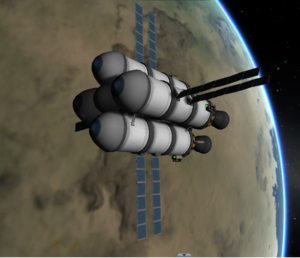Difference between revisions of "Satellite"
From Kerbal Space Program Wiki
Wthunderace (talk | contribs) |
Wthunderace (talk | contribs) |
||
| Line 10: | Line 10: | ||
Artificial satellites can be used for unmanned flights to test rocket designs, or to travel to other planetary bodies to collect | Artificial satellites can be used for unmanned flights to test rocket designs, or to travel to other planetary bodies to collect | ||
scientific data. With the addition of the [[career mode]] and [[science mode]], satellites are not available until later in a game due to the lack of [[Command module|command probes]]. | scientific data. With the addition of the [[career mode]] and [[science mode]], satellites are not available until later in a game due to the lack of [[Command module|command probes]]. | ||
| + | [[File:Screenshot2.png|thumbnail|An artificial satellite in low orbit around the planet Kerbin, pictured here above the desert biome]] | ||
[[Category:Craft]] | [[Category:Craft]] | ||
Revision as of 08:46, 1 December 2015
A satellite is any object orbiting a celestial body, called its primary. Satellites can be naturally created orbiting bodies (planets, moons, asteroids), or artificial objects (probes, space stations, etc.).
Natural satellites
Any celestial body that orbits a larger body is a natural satellite. Planets are satellites of Kerbol. Moons are satellites of planets. Asteroids may be satellites of either Kerbol or planets, depending on their primaries. It's also possible for asteroids orbiting Kerbol to become captured naturally by a planet, depending on their size and entry angle.
Artificial satellites
- → Main article: Probe
Artificial satellites can be used for unmanned flights to test rocket designs, or to travel to other planetary bodies to collect
scientific data. With the addition of the career mode and science mode, satellites are not available until later in a game due to the lack of command probes.
